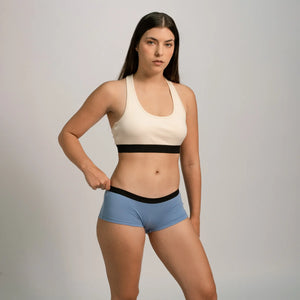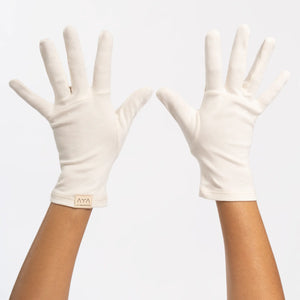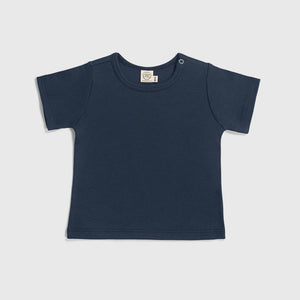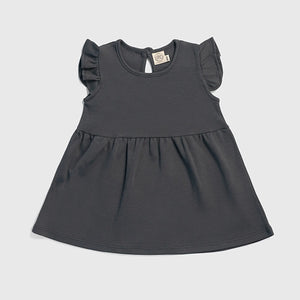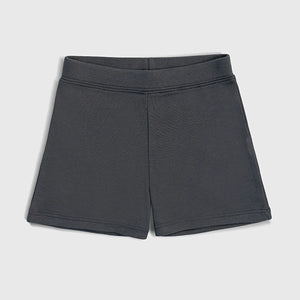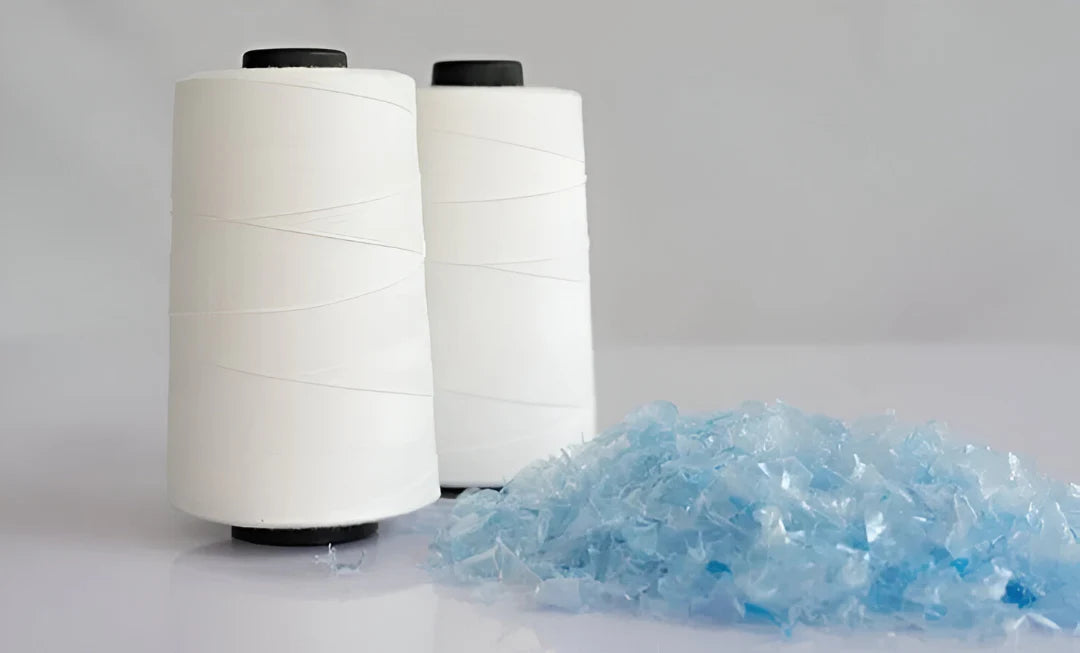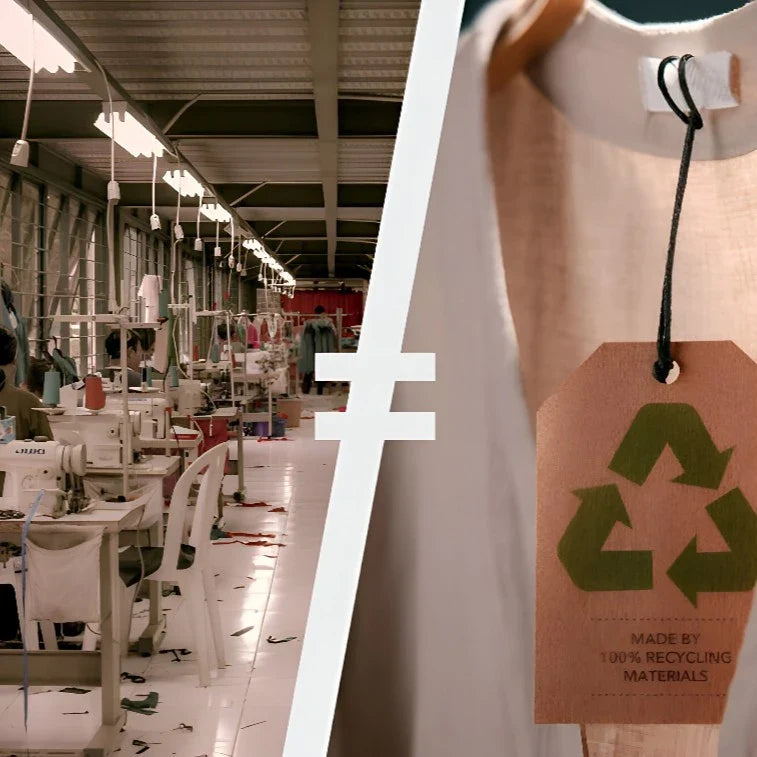Synthetic Fibers & Natural Alternatives:
Unmasking the health risks of microplastics
.
AYA | JUNE 2, 2025
READING TIME: 8 minutes
By Jordy Munarriz
AYA | JUNE 2, 2025
READING TIME: 8 minutes
By Jordy Munarriz
Synthetic fibers—polyester, nylon, acrylic—dominate modern wardrobes, prized for their affordability and durability. Yet mounting evidence shows that these materials can compromise our health at every level: from the lungs to the gut, skin to cellular DNA. In this article, we unpack scientific findings, the risks of daily exposure, and explore practical steps toward a safer, more natural closet.
Respiratory System: Inhaling Invisible Threats
Microfiber Inhalation & Lung Disease
Synthetic microfibers—derived from materials like polyester, nylon, and acrylic—are increasingly recognized as a significant environmental and health threat. Once airborne, these particles can be inhaled and become embedded deep within the lung tissue, where they have the potential to cause lasting harm.
A growing body of research confirms that synthetic microfibers, measuring as small as 12 × 31 μm for nylon and up to 15 × 52 μm for polyester [1]—1 micrometer is one-millionth of a meter [2]—are present in the indoor air we breathe. Notably, they can easily enter the human respiratory system through regular inhalation [1]. Alarmingly, studies on human autopsies show that synthetic fibers were found in 97% of lung tissue samples taken from patients suffering from chronic respiratory diseases [3].
Synthetic microfibers don’t just float through the air—they accumulate in human lung tissue over time. In fact, the concentrations of these fibers in lung tissue are alarmingly high. Occupational studies have revealed that between 15-40% of workers exposed to synthetic fibers in textile factories have developed work-related pulmonary and respiratory diseases [4]. The longer the exposure, the greater the likelihood of developing chronic lung conditions, including pulmonary fibrosis, reduced lung function, and even early-onset emphysema [2,5].
Even outside of industrial settings, synthetic microfibers are having a harmful impact. A typical home dryer has been shown to release between 433,128 and 561,810 microfibers into the air during just 15 minutes of operation, with each cycle contributing significantly to indoor air pollution [6]. The concentration of these microfibers in indoor environments is notably higher than outdoors. Studies have documented levels of microplastics in indoor air reaching 1,490 ± 1,100 particles/m³, compared to just 189 ± 85 particles/m³ outdoors—roughly 8 times more concentrated indoors [7].

Image by: Mehmood Saddique.
Cellular-Level Damage
At a cellular level, inhaled microfibers trigger inflammation and oxidative stress. Laboratory-grown "mini lungs" exposed to nylon microfibers showed disrupted cell differentiation, impairing the lung’s ability to regenerate tissue after damage [8].
Animal studies reinforce these concerns: mice exposed to tire-derived microplastics developed fibrotic lesions in their lungs and chronic inflammation, similar to what is seen in early stages of interstitial lung diseases [9].
Additional studies in 2024 confirmed that persistent exposure to synthetic particles results in oxidative damage to lung cells, contributing to long-term respiratory conditions [10].
Fiber Size & Toxicity Comparison
| Fiber Type | Diameter (µm) | Penetration Depth | Biopersistence & Toxicity | Biodegradability |
|---|---|---|---|---|
| Synthetic Microfibers | 0.5 – 3 | Alveoli (deep lung) | High: evade clearance, cause chronic inflammation, fibrosis, potential carcinogenicity | Very low (centuries) |
| Cotton Fibers | 10 - 45 | Upper airways | Low: cleared by mucociliary action; residual pesticides may irritate skin but minimal lung risk | High (weeks–months) |
| Animal Fibers (alpaca, merino) | 10 - 50 | Bronchi & throat | Low–Moderate: protein fibers degrade enzymatically; rare irritant reactions in sensitive individuals | High (months) |
Digestive System: When Plastics Enter the Gut
Ingestion and Gastrointestinal Impact
Microplastics have become ubiquitous in our environment, infiltrating our food, water, and even the air we breathe. Consequently, ingestion of these particles is almost unavoidable [3]. Once inside the gastrointestinal tract, microplastics can induce inflammation, oxidative stress, and disrupt the gut microbiome, leading to a cascade of health issues [3,11].
A study published in Environmental Health Perspectives highlighted that microplastics can translocate from the gut into other organs, including the liver, kidneys, and brain, suggesting systemic exposure beyond the digestive system [3,12].
Disruption of the Gut Microbiome
The gut microbiome—a complex community of trillions of microorganisms residing in the digestive tract—is essential to our health.
Microplastics and synthetic fibers don't just pollute the air. Once inside the body, these microscopic particles can disrupt the natural balance of the gut microbiota, a condition known as dysbiosis [13]. This occurs when harmful bacteria begin to outnumber beneficial ones, weakening the gut's ability to regulate inflammation, nutrient absorption, and immune defense. These changes have been linked to gastrointestinal disorders, metabolic disease, and reduced immune resilience [14].
Moreover, synthetic fibers specifically, when ingested, have been found to trigger intestinal inflammation, oxidative stress, and microbial imbalances [3,5]. These physiological changes not only impair gut function but can contribute to the onset of chronic digestive conditions.For example, exposure to nylon fiber increases the risk of inflammatory bowel diseases such as Crohn’s disease and ulcerative colitis [3]—highlighting the potential for serious long-term health consequences.
Potential Link to Colorectal Cancer
Emerging studies suggest a potential association between microplastic exposure and an increased risk of early-onset colorectal cancer (EOCRC) [15]. The ingestion of microplastics may lead to chronic inflammation and damage to the intestinal lining, creating a conducive environment for carcinogenesis [15].
While more research is needed to establish a definitive causal relationship, these findings underscore the importance of minimizing microplastic exposure to safeguard digestive health.

Pacific water sample with visible microplastic residue. Picture by: Marg Johnson.
Skin & Dermal Absorption: Clothes That React
Irritation & Allergies
Synthetic fabrics, such as polyester, nylon, and spandex, are prevalent in modern clothing due to their durability and stretch. However, these materials can pose challenges for individuals with sensitive skin. Up to 70% of sensitive-skinned individuals report experiencing rashes or contact dermatitis when wearing synthetic fabrics, especially during exercise or in hot conditions [16,17]. This is often attributed to embedded additives like phthalates and heavy-metal dyes.
Furthermore, up to 60-70% of patients with atopic dermatitis report worsening symptoms while wearing synthetic clothing.The lack of breathability in synthetic fabrics can exacerbate these issues by trapping heat and moisture against the skin [18].
Impact on Women's Health: Synthetic Underwear and Vaginal Well-being
Moisture Retention and Infections
Synthetic fabrics—such as polyester, nylon, and spandex—tend to trap heat and moisture against the skin, especially in the intimate area. This creates a warm, humid environment that is ideal for the overgrowth of yeast and harmful bacteria, significantly increasing the risk of vaginal infections like candidiasis (yeast infections) and bacterial vaginosis [19]. Unlike natural fibers, synthetic materials lack breathability and do not wick moisture effectively, leading to discomfort and an elevated risk of irritation and imbalance in the vaginal microbiome [5,19].
Chemical Exposure: Endocrine Disruptors and Hormonal Health
Beyond moisture retention, synthetic underwear often exposes wearers to harmful chemicals embedded in the fabric. Laboratory analyses have detected the presence of endocrine-disrupting chemicals (EDCs) such as bisphenols, phthalates, and nonylphenols in textiles, including intimate garments [5,20,21]. These substances can leach from the fabric and be absorbed through the skin—especially in areas with thinner, more permeable dermal layers like the vulva [5,22].
Endocrine disruptors are chemicals that interfere with the body’s hormonal systems, and their impact on women’s reproductive health is increasingly documented. Chronic exposure, even at low doses, has been associated with a range of health concerns, including:
- Fertility issues, such as anovulation (absence of ovulation) and reduced embryo implantation success rates [22].
- Menstrual and ovarian disorders, including polycystic ovary syndrome (PCOS) and endometriosis—two highly prevalent conditions among women of reproductive age, which have been linked to prolonged exposure to bisphenols and phthalates [23].
- Increased risk of hormone-sensitive cancers, including breast, uterine, and ovarian cancer [23].
- Pregnancy complications, such as spontaneous miscarriage, congenital malformations, and impaired fetal development [5,24].
The route of exposure through prolonged dermal contact with chemically treated synthetic fabrics—such as those used in conventional women’s underwear—is a growing concern. In light of these findings, choosing natural, breathable, and chemical-free fabrics—like organic cotton or alpaca wool— for intimate wear is more than a comfort preference. It is a proactive choice for protecting reproductive and hormonal health.

Systemic & Chronic Effects: Beyond Skin Deep
Mounting research suggests prolonged exposure to synthetic fibers and the chemicals they contain. We've already mentioned the effects targeting women's hormonal and endocrine systems. We'll now describe how they potentially contribute to endocrine disruption, cellular damage, and chronic disease.
Endocrine Disruption & Hormonal Imbalance
These endocrine-disrupting chemicals (EDCs) can mimic, block, or alter hormone signals in the body, even at low doses.
- Phthalates, commonly used to soften plastics, have been found in synthetic clothes and especially activewear. When absorbed through the skin or inhaled, they can interfere with the production of estrogen and testosterone, potentially affecting fertility in both men and women [21,25].
- Bisphenol A (BPA), known for its role in hard plastics, is also present in some textile coatings. Chronic exposure has been linked thyroid dysfunction, obesity, and metabolic disorders [26,27,28].
Microplastics in Organs & the Bloodstream
Microfibers shed from synthetic clothing are small enough to be inhaled or ingested—and recent studies confirm that they don't just pass through the body.
- Placenta Penetration: A groundbreaking 2021 study found microplastics in human placental tissue, raising concerns about fetal exposure and developmental risks [29,30] .
- Bloodstream Contamination: In 2022, a research detected microplastics in human blood, including PET and polystyrene particles likely originating from food packaging and synthetic fibers [29].
These findings suggest microfibers can cross biological barriers once thought impermeable, potentially accumulating in the liver, kidneys, and brain.
Oxidative Stress & Cellular Aging
Exposure to synthetic textiles may also promote oxidative stress, a physiological imbalance between free radicals and antioxidants in the body [31]. This condition is associated with [31,32,33]:
- DNA fragmentation.
- Protein and lipid damage.
- Accelerated cellular aging.
- Inflammatory disorders and neurodegeneration.
Animal models exposed to microplastics show increased markers of oxidative stress, and similar results have been observed in human lung and gut cell cultures exposed to textile fibers.
Changing Demographics and Preferences
The pandemic also highlighted shifting demographics in the fashion market. Younger consumers, particularly Gen Z and Millennials, became increasingly influential in shaping purchasing trends. Research from the Institute for Sustainable Fashion indicates that younger generations are more likely to support sustainable brands, with 83% of Millennials stating they prefer to buy from companies that share their values [7,8].
Moreover, with the rise of remote work, many consumers reported a preference for comfort over style. A study published in the Journal of Fashion Marketing and Management noted that comfort became the primary driver of clothing purchases for many consumers, with 65% prioritizing comfort in their buying decisions [9]. This trend is likely to persist as remote work becomes a more permanent aspect of many industries.

Changing Demographics and Preferences
The pandemic also highlighted shifting demographics in the fashion market. Younger consumers, particularly Gen Z and Millennials, became increasingly influential in shaping purchasing trends. Research from the Institute for Sustainable Fashion indicates that younger generations are more likely to support sustainable brands, with 83% of Millennials stating they prefer to buy from companies that share their values [7,8].
Moreover, with the rise of remote work, many consumers reported a preference for comfort over style. A study published in the Journal of Fashion Marketing and Management noted that comfort became the primary driver of clothing purchases for many consumers, with 65% prioritizing comfort in their buying decisions [9]. This trend is likely to persist as remote work becomes a more permanent aspect of many industries.

Changing Demographics and Preferences
The pandemic also highlighted shifting demographics in the fashion market. Younger consumers, particularly Gen Z and Millennials, became increasingly influential in shaping purchasing trends. Research from the Institute for Sustainable Fashion indicates that younger generations are more likely to support sustainable brands, with 83% of Millennials stating they prefer to buy from companies that share their values [7,8].
Moreover, with the rise of remote work, many consumers reported a preference for comfort over style. A study published in the Journal of Fashion Marketing and Management noted that comfort became the primary driver of clothing purchases for many consumers, with 65% prioritizing comfort in their buying decisions [9]. This trend is likely to persist as remote work becomes a more permanent aspect of many industries.

Changing Demographics and Preferences
The pandemic also highlighted shifting demographics in the fashion market. Younger consumers, particularly Gen Z and Millennials, became increasingly influential in shaping purchasing trends. Research from the Institute for Sustainable Fashion indicates that younger generations are more likely to support sustainable brands, with 83% of Millennials stating they prefer to buy from companies that share their values [7,8].
Moreover, with the rise of remote work, many consumers reported a preference for comfort over style. A study published in the Journal of Fashion Marketing and Management noted that comfort became the primary driver of clothing purchases for many consumers, with 65% prioritizing comfort in their buying decisions [9]. This trend is likely to persist as remote work becomes a more permanent aspect of many industries.


Image by: Hull York Medical School.
Vulnerable Groups: When Exposure Hits Hardest
While synthetic fibers pose health risks to the general population, certain groups are disproportionately affected due to their physiology, working conditions, or developmental stage.
Children: Small Lungs, Big Risks
Children inhale up to three times more microplastics than adults because of their higher respiratory rate and closer proximity to dust-laden surfaces [3,34]. Their lungs are still developing, making them more vulnerable to inflammatory damage caused by microfibers and airborne toxins. A study from the University of Oklahoma found that indoor environments—where children spend over 90% of their time—can be reservoirs of airborne microplastics, especially from synthetic carpets, upholstery, and clothing [34]. Potential impacts include:
Women: Endocrine Disruption & Reproductive Harm
Women may be at greater risk due to higher dermal contact (e.g., tight synthetic activewear, bras, and underwear), especially in hot, humid conditions. Chemical additives in these fabrics—like BPA and phthalates—can act as xenoestrogens, interfering with hormonal signaling [19,26,27,28,29].
Textile Workers: Breathing in the Fabric of Risk
Factory and garment workers often operate in high-fiber concentration environments with poor ventilation. Studies show that up to 4% of these workers develop interstitial lung diseases, including fibrosis and chronic bronchitis, linked to fiber inhalation and long-term chemical exposure [35,36].

What You Can Do: Health-Smart Habits for a Synthetic-Free Life
- Choose natural and breathable fabrics like 100% organic cotton or alpaca wool for everyday wear—especially underwear and activewear—to minimize chemical absorption and allow proper airflow.
- Avoid tight-fitting underwear and clothing, particularly in warm or humid conditions. Friction and trapped moisture can increase the risk of irritation, yeast infections, and bacterial vaginosis.
- Wash clothes in cold water and air dry whenever possible. This simple shift reduces microfiber shedding by up to 80% and preserves fabric integrity.
- Install a microfiber-catching filter on your washing machine. These devices trap up to 90% of fibers before they can pollute waterways—or your indoor air.
- Rinse new clothes before wearing to remove residual dyes, formaldehyde, and finishing agents often left on synthetic garments from the factory.
- Read clothing labels carefully. Watch for polyester, nylon, acrylic, and elastane blends—especially in intimate or skin-tight garments.
- Avoid "moisture-wicking" synthetics during workouts if you have sensitive skin or are prone to infections. Natural fabrics wick moisture effectively without chemical coatings.
- Support transparent, ethical brands that disclose their textile sources and avoid petroleum-based blends.
- Raise awareness in your community—host clothing swaps, support eco-friendly laundromats, or educate peers about health risks tied to fast fashion.
The synthetic clothing industry has long sold us performance, affordability, and convenience—but rarely accountability. Every microplastic thread in our lungs, every drop of BPA in our sweat, and every fiber shed into our oceans tells the same story: the cost of synthetic fashion is being outsourced to our bodies.
At AYA, we believe your clothing should support your health—not compromise it. That’s why we exclusively use 100% natural materials like organic cotton and pure alpaca wool, carefully sourced and ethically produced in Peru. We prioritize transparency in every step of our process, from fiber to final garment. Our mission isn’t just to create beautiful, non-toxic clothing—it’s also to educate and empower conscious consumers to make informed choices. Because when you know what’s in your clothes, you protect both your body and the planet.
So the question remains: What are we putting on our skin without even realizing it?

Glossarykeywords
Anovulation:
The absence of ovulation in the menstrual cycle, often linked to hormone disruption caused by chemicals like BPA and phthalates.
Atopic Dermatitis:
A chronic skin condition (eczema) that flares with exposure to irritants—including synthetic fabrics and their chemical additives.
Bacterial Vaginosis (BV):
A vaginal imbalance caused by the overgrowth of harmful bacteria. Triggered by warmth, trapped moisture, and lack of airflow—conditions common with synthetic underwear.
Bioaccumulation:
The gradual buildup of substances (like microplastics or chemicals) in the body over time due to repeated exposure.
Biopersistence:
The ability of a substance to resist degradation and remain inside the body for extended periods, potentially causing long-term harm.
Bisphenol A (BPA):
A synthetic chemical used in plastics and textile coatings. BPA mimics estrogen in the body and has been linked to hormonal imbalances, infertility, and cancer.
Candidiasis:
A common fungal infection (often called a yeast infection) that can occur when moisture and heat accumulate, particularly in non-breathable synthetic underwear.
Colorectal Cancer (CRC):
Cancer of the colon or rectum. Emerging studies link early-onset cases to chronic gut inflammation potentially caused by microplastic exposure.
Dermal Absorption:
The process by which chemicals in textiles can pass through the skin and enter the bloodstream, particularly in areas with thin or sensitive skin.
Dysbiosis:
A disruption in the natural balance of gut bacteria. This condition can weaken digestion, immunity, and even affect mental health.
Endocrine Disruptors (EDCs):
Chemicals that interfere with the body’s hormone systems. Linked to fertility issues, cancers, and hormonal disorders.
Endocrine System:
The collection of glands and hormones regulating metabolism, reproduction, and growth. Synthetic chemicals can interfere with its function.
Endometriosis:
A painful condition in which tissue similar to the uterine lining grows outside the uterus. Studies have associated increased risk with chemical exposures through clothing and environment.
Fibrosis:
Thickening and scarring of tissue, especially in the lungs, caused by persistent irritation—such as from inhaled microfibers.
Interstitial Lung Disease:
A group of chronic respiratory disorders caused by scarring (fibrosis) of lung tissue. Long-term inhalation of synthetic fibers can contribute to its development.
Microplastics:
Tiny plastic particles less than 5 millimeters in size that result from the breakdown of larger plastic waste.
Nonylphenols
Toxic surfactants used in some textile processes. They can disrupt hormone function and persist in the environment.
Oxidative Damage:
Harm to cells caused by free radicals. Linked to premature aging, respiratory issues, and chronic disease.
Oxidative Stress:
A cellular imbalance between free radicals and antioxidants, leading to inflammation, DNA damage, and accelerated aging. Often triggered by exposure to pollutants like microplastics.
PCOS (Polycystic Ovary Syndrome):
A hormonal disorder affecting ovulation and metabolism. Research suggests a link between PCOS and exposure to endocrine-disrupting chemicals.
Phthalates:
Plasticizing agents used to increase flexibility in plastics and synthetic fabrics. Known endocrine disruptors associated with reproductive and metabolic disorders.
Synthetic Fibers:
Man-made textile fibers produced from petroleum-based chemicals, including polyester, nylon, acrylic, and spandex.
Systemic Exposure:
When a substance spreads throughout the body, often via the bloodstream, affecting multiple organs.
Translocation (in biology):
The movement of microplastics or chemicals from one part of the body (e.g., gut) to another (e.g., liver or brain).
Xenoestrogens:
Synthetic compounds that imitate estrogen in the body, disrupting natural hormonal balance. Found in many EDCs used in clothing production.
Authors & Researchers

Jordy Munarriz
Environmental Engineer with a master's degree in renewable energy and a specialization in sustainability. Researcher and writer, he combines his technical knowledge with his passion for environmental communication, addressing topics of ecological impact and sustainable solutions in the textile industry and beyond.
Authors & Researchers
Authors & Researchers

Jordy Munarriz
Environmental Engineer with a master's degree in renewable energy and a specialization in sustainability. Researcher and writer, he combines his technical knowledge with his passion for environmental communication, addressing topics of ecological impact and sustainable solutions in the textile industry and beyond.
References:
[1] Song S, van Dijk F, Vasse GF, Liu Q, Gosselink IF, Weltjens E, et al. Inhalable Textile Microplastic Fibers Impair Airway Epithelial Differentiation. Am J Respir Crit Care Med . 2024 Feb 15;209(4):427-443. doi: 10.1164/rccm.202211-2099OC. PMID: 37971785.
[2] Williams M, McClure PR. Toxicological Profile for Synthetic Vitreous Fibers. Atlanta (GA): Agency for Toxic Substances and Disease Registry; 2004 Sep.
[3] Dethmers K, Spek H, Kraaijeveld B. Do Clothes Make Us Sick? Fashion, Fibers and Human Health. Amsterdam: Plastic Soup Foundation; 2022 Oct.
[4] Song S, van Dijk F, Vasse GF, Liu Q, Gosselink IF, Weltjens E, Remels AHV, de Jager MH, Bos S, Li C, Stoeger T, Rehberg M, Kutschke D, van Eck G, Wu X, Willems SH, Boom D, Kooter IM, Spierings D, Wardenaar R, Cole MJ, Nawijn MC, Salvati A, Gosens R, Melgert BN. Inhalable textile microplastic fibers impair airway epithelial differentiation. Am J Respir Crit Care Med. 2023 Nov 16;209(4):427-443. doi: 10.1164/rccm.202211-2099OC.
[5] Dutchen S. Microplastics everywhere. Harvard Medicine Magazine. 2023 Spring. Available from: https://magazine.hms.harvard.edu/articles/microplastics-everywhere
[6] Tao D, Zhang K, Xu S, Lin H, Liu Y, Kang J, Yim T, Giesy JP, Leung KMY. Microfibers released into the air from a household tumble dryer. Environ Sci Technol Lett. 2022;9(2):120–6. Available from: https://pubs.acs.org/doi/10.1021/acs.estlett.1c00911
[7] Gaylarde CC, Baptista Neto JA, da Fonseca EM. Indoor airborne microplastics: human health importance and effects of air filtration and turbulence. Microplastics. 2024;3(4):653-670. doi:10.3390/microplastics3040040.
[8] Melgert BN. Microplastics and their effects on the human body. University of Groningen; 2025 Apr 22.
[9] Vasse GF, Melgert BN. Microplastic and plastic pollution: impact on respiratory disease and health. Eur Respir Rev. 2024 Jun 12;33(172):230226. doi: 10.1183/16000617.0226-2023. PMID: 39009408; PMCID: PMC11262622.
[10] Tomonaga T, Higashi H, Izumi H, et al. Investigation of pulmonary inflammatory responses following intratracheal instillation of and inhalation exposure to polypropylene microplastics. Part Fibre Toxicol. 2024;21:29. doi: 10.1186/s12989-024-00592-8.
[11] Bora SS, Gogoi R, Sharma MR, Anshu, Borah MP, Deka P, et al. Microplastics and human health: unveiling the gut microbiome disruption and chronic disease risks. Front Cell Infect Microbiol. 2024 Nov 24;14:1492759. doi: 10.3389/fcimb.2024.1492759.
[12] University of New Mexico Health Sciences Center. Microplastics make their way from the gut to other organs. UNM HSC Newsroom. 2024 Apr 12. Available from: https://hscnews.unm.edu/news/microplastics-in-organs
[13] Shen Y, Fan N, Ma SX, Cheng X, Yang X, Wang G. Gut microbiota dysbiosis: pathogenesis, diseases, prevention, and therapy. MedComm (2020). 2025 Apr 18;6(5):e70168. doi: 10.1002/mco2.70168. PMID: 40255918; PMCID: PMC12006732.
[14] Tamargo A, Molinero N, Reinosa JJ, Gutiérrez L, Real C, Jiménez R, et al. PET microplastics affect human gut microbiota communities during simulated gastrointestinal digestion, first evidence of plausible polymer biodegradation during human digestion. Sci Rep. 2022;12:528. doi: 10.1038/s41598-021-04489-w.
[15] Mashayekhi-Sardoo H, Ghoreshi ZAS, Askarpour H, Arefinia N, Ali-Hassanzadeh M. The clinical relevance of microplastic exposure on colorectal cancer: A systematic review. Cancer Epidemiol. 2025 Aug;97:102840. https://doi.org/10.1016/j.canep.2025.102840
[16] Celiker U, Ilhan N, Ozercan I, Demir T, Celiker H. Octreotide reduces ischaemia-reperfusion injury in the retina. Acta Ophthalmol Scand. 2002 Aug;80(4):395-400. doi: 10.1034/j.1600-0420.2002.800409.x. PMID: 12190782.
[17] Kallini JR, Riaz F, Khachemoune A. Tinea versicolor in dark-skinned individuals. Int J Dermatol. 2014 Feb;53(2):137–41. doi: 10.1111/ijd.12345.
[18] Mellerio JE. Infection and colonization in epidermolysis bullosa. Dermatol Clin. 2010 Apr;28(2):267–9. doi: 10.1016/j.det.2010.01.004.
[19] Carter KA, Balkus JE, Anzala O, Kimani J, Hoffman NG, Fiedler TL, Mochache V, Fredricks DN, McClelland RS, Srinivasan S. Associations between vaginal bacteria and bacterial vaginosis signs and symptoms: a comparative study of Kenyan and American women. Front Cell Infect Microbiol. 2022 Mar 3;12:801770. doi: 10.3389/fcimb.2022.801770.
[20] Rovira J, Souza MCO, Nadal M, Domingo JL. Human health risks from textile chemicals: a critical review of recent evidence (2019–2025). Qeios [Internet]. 2025 Apr 18 [cited 2025 Jun 2]; Available from: https://doi.org/10.32388/0GADTB.2
[21] Liu J, Zhang L, Lu G, Jiang R, Yan Z, Li Y. Occurrence, toxicity and ecological risk of Bisphenol A analogues in aquatic environment – A review. Ecotoxicol Environ Saf. 2021 Jan 15;208:111481. doi: 10.1016/j.ecoenv.2020.111481.
[22] Marconetto A, Babini A, Ñañez M, Moreno L, Rosato O, Fux Otta C. Principales disruptores endocrinos vinculados con salud reproductiva femenina: bases biológicas de su asociación [Main endocrine disruptors related to female reproductive health: biological basis of their association]. Medicina (B Aires). 2022 Aug;82(3).
[23] Wedel Herrera K. Disruptores endocrinos: un riesgo para la salud reproductiva. Rev méd sinerg [Internet]. 2019 Jun 1 [cited 2025 Jun 2];4(6):24-30. Available from: https://revistamedicasinergia.com/index.php/rms/article/view/242
[24] Rolfo A, Nuzzo AM, De Amicis R, Moretti L, Bertoli S, Leone A. Fetal-maternal exposure to endocrine disruptors: correlation with diet intake and pregnancy outcomes. Nutrients. 2020 Jun 11;12(6):1744. doi: 10.3390/nu12061744. PMID: 32545151; PMCID: PMC7353272.
[25] Wang Y, Qian H. Phthalates and their impacts on human health. Healthcare (Basel). 2021 May 18;9(5):603. doi: 10.3390/healthcare9050603. PMID: 34069956; PMCID: PMC8157593.
[26] García García M, Picó Y, Morales-Suárez-Varela M. Effects of Bisphenol A on the risk of developing obesity. Nutrients. 2024 Oct 31;16(21):3740. doi: 10.3390/nu16213740.
[27] Rubin BS. Bisphenol A: An endocrine disruptor with widespread exposure and multiple effects. J Steroid Biochem Mol Biol. 2011 Oct;127(1-2):27-34. doi: 10.1016/j.jsbmb.2011.05.002.
[28] Gore AC, Chappell VA, Fenton SE, Flaws JA, Nadal A, Prins GS, Toppari J, Zoeller RT. EDC-2: The Endocrine Society's Second Scientific Statement on Endocrine-Disrupting Chemicals. Endocr Rev. 2015 Dec;36(6):E1–E150. doi: 10.1210/er.2015-1010.
[29] Leslie HA, van Velzen MJM, Brandsma SH, Vethaak AD, Garcia-Vallejo JJ, Lamoree MH. Discovery and quantification of plastic particle pollution in human blood. Environ Int. 2022 May;163:107199. doi: 10.1016/j.envint.2022.107199.
[30] Ragusa A, Svelato A, Santacroce C, Catalano P, Notarstefano V, Carnevali O, Papa F, Rongioletti MCA, Baiocco F, Draghi S, D'Amore E, Rinaldo D, Matta M, Giorgini E. Plasticenta: First evidence of microplastics in human placenta. Environ Int. 2021 Jan;146:106274. doi: 10.1016/j.envint.2020.106274. Epub 2020 Dec 2. PMID: 33395930.
[31] Prata JC, da Costa JP, Lopes I, Duarte AC, Rocha-Santos T. Environmental exposure to microplastics: An overview on possible human health effects. Sci Total Environ. 2020 Feb 1;702:134455. doi: 10.1016/j.scitotenv.2019.134455.
[32] Al-Thani RF, Yasseen BT. Phytoremediation of polluted soils and waters by native Qatari plants: Future perspectives. Environ Pollut. 2020 Apr;259:113694. doi: 10.1016/j.envpol.2019.113694.
[33] Hurley RR, Lusher AL, Olsen M, Nizzetto L. Validation of a method for extracting microplastics from complex, organic-rich, environmental matrices. Environ Sci Technol. 2018 Jun 9;52(13):7409-17. doi: 10.1021/acs.est.8b02211.
[34] Gaylarde CC, Baptista Neto JA, da Fonseca EM. Indoor airborne microplastics: human health importance and effects of air filtration and turbulence. Microplastics. 2024;3(4):653-670. doi: 10.3390/microplastics3040040.
[35] Ghio AJ, Funkhouser W, Pugh CB, Winters S, Stonehuerner JG, Mahar AM, Roggli VL. Pulmonary fibrosis and ferruginous bodies associated with exposure to synthetic fibers. Toxicol Pathol. 2006;34(6):723-9. doi: 10.1080/01926230600932448. PMID: 17074740.
[36] Scarlat I, Stepa R, Haiducu M, Visileanu E, Grosu MC. Workers exposure to synthetic textiles microfibers. MATEC Web Conf. 2024;389:00080. doi: 10.1051/matecconf/202438900080.
Glossarykeywords
Anovulation:
The absence of ovulation in the menstrual cycle, often linked to hormone disruption caused by chemicals like BPA and phthalates.
Atopic Dermatitis:
A chronic skin condition (eczema) that flares with exposure to irritants—including synthetic fabrics and their chemical additives.
Bacterial Vaginosis (BV):
A vaginal imbalance caused by the overgrowth of harmful bacteria. Triggered by warmth, trapped moisture, and lack of airflow—conditions common with synthetic underwear.
Bioaccumulation:
The gradual buildup of substances (like microplastics or chemicals) in the body over time due to repeated exposure.
Biopersistence:
The ability of a substance to resist degradation and remain inside the body for extended periods, potentially causing long-term harm.
Bisphenol A (BPA):
A synthetic chemical used in plastics and textile coatings. BPA mimics estrogen in the body and has been linked to hormonal imbalances, infertility, and cancer.
Candidiasis:
A common fungal infection (often called a yeast infection) that can occur when moisture and heat accumulate, particularly in non-breathable synthetic underwear.
Colorectal Cancer (CRC):
Cancer of the colon or rectum. Emerging studies link early-onset cases to chronic gut inflammation potentially caused by microplastic exposure.
Dermal Absorption:
The process by which chemicals in textiles can pass through the skin and enter the bloodstream, particularly in areas with thin or sensitive skin.
Dysbiosis:
A disruption in the natural balance of gut bacteria. This condition can weaken digestion, immunity, and even affect mental health.
Endocrine Disruptors (EDCs):
Chemicals that interfere with the body’s hormone systems. Linked to fertility issues, cancers, and hormonal disorders.
Endocrine System:
The collection of glands and hormones regulating metabolism, reproduction, and growth. Synthetic chemicals can interfere with its function.
Endometriosis:
A painful condition in which tissue similar to the uterine lining grows outside the uterus. Studies have associated increased risk with chemical exposures through clothing and environment.
Fibrosis:
Thickening and scarring of tissue, especially in the lungs, caused by persistent irritation—such as from inhaled microfibers.
Interstitial Lung Disease:
A group of chronic respiratory disorders caused by scarring (fibrosis) of lung tissue. Long-term inhalation of synthetic fibers can contribute to its development.
Microplastics:
Tiny plastic particles less than 5 millimeters in size that result from the breakdown of larger plastic waste.
Nonylphenols
Toxic surfactants used in some textile processes. They can disrupt hormone function and persist in the environment.
Oxidative Damage:
Harm to cells caused by free radicals. Linked to premature aging, respiratory issues, and chronic disease.
Oxidative Stress:
A cellular imbalance between free radicals and antioxidants, leading to inflammation, DNA damage, and accelerated aging. Often triggered by exposure to pollutants like microplastics.
PCOS (Polycystic Ovary Syndrome):
A hormonal disorder affecting ovulation and metabolism. Research suggests a link between PCOS and exposure to endocrine-disrupting chemicals.
Phthalates:
Plasticizing agents used to increase flexibility in plastics and synthetic fabrics. Known endocrine disruptors associated with reproductive and metabolic disorders.
Synthetic Fibers:
Man-made textile fibers produced from petroleum-based chemicals, including polyester, nylon, acrylic, and spandex.
Systemic Exposure:
When a substance spreads throughout the body, often via the bloodstream, affecting multiple organs.
Translocation (in biology):
The movement of microplastics or chemicals from one part of the body (e.g., gut) to another (e.g., liver or brain).
Xenoestrogens:
Synthetic compounds that imitate estrogen in the body, disrupting natural hormonal balance. Found in many EDCs used in clothing production.
Glossarykeywords
Bamboo:
The term "bamboo fabric" generally refers to a variety of textiles made from the bamboo plant. Most bamboo fabric produced worldwide is bamboo viscose, which is economical to produce, although it has environmental drawbacks and poses occupational hazards.
Cellulose Nanocrystals (CNCs):
They are rod-shaped nanoparticles derived from cellulose. They are biodegradable and renewable materials used in various fields, such as construction, medicine, and crude oil separation.
Circularity in the Textile Value Chain:
It seeks to design durable, recyclable, and long-lasting textiles. The goal is to create a closed-loop system where products are reused and reincorporated into production.
Cotton:
A soft white fibrous substance that surrounds the seeds of a tropical and subtropical plant and is used as textile fiber and thread for sewing.
Fertilizers:
These are nutrient-rich substances used to improve soil characteristics for better crop development. They may contain chemical additives, although there are new developments in the use of organic substances in their production.
Jute:
It is a fiber derived from the jute plant. This plant is composed of long, soft, and lustrous plant fibers that can be spun into thick, strong threads. These fibers are often used to make burlap, a thick, inexpensive material used for bags, sacks, and other industrial purposes. However, jute is a more refined version of burlap, with a softer texture and a more polished appearance.
Hemp:
Industrial hemp is used to make clothing fibers. It is the product of cultivating one of the subspecies of the hemp plant for industrial purposes.
Linen:
It is a plant fiber that comes from the plant of the same name. It is very durable and absorbent, and dries faster than cotton. Thanks to these properties, it is comfortable to wear in warm climates and is valued for making clothing.
Organic Cotton:
It is grown with natural seeds, sustainable irrigation methods, and no pesticides or other harmful chemicals are used in its cultivation. As a result, organic cotton is presented as a healthier alternative for the skin.
Pesticides:
It is a substance used to control, eliminate, repel, or prevent pests. Industry uses chemical pesticides for economic reasons.
Subsidy:
It can be defined as any government assistance or incentive, in cash or kind, towards private sectors - producers or consumers - for which the Government does not receive equivalent compensation in return.
The International Day of Zero Waste:
It is celebrated annually on March 30. The day's goal is to promote sustainable consumption and production and raise awareness about zero-waste initiatives.
UNEP:
The United Nations Environment Programme is responsible for coordinating responses to environmental problems within the United Nations system.
Water-Intensive Practices:
These are activities that consume large amounts of water. These practices can have significant environmental impacts, especially in water-scarce regions.
World Water Day:
It is an international celebration of awareness in the care and preservation of water that has been celebrated annually on March 22 since 1993.
Glossarykeywords
Artisan:
A skilled craftsperson who makes products by hand, often using traditional methods passed down through generations.
Dignity:
The state of being worthy of respect. In fashion, it refers to treating workers as valuable human beings, not disposable labor.
Exploitation:
The unfair treatment or use of someone for personal gain, especially by paying them unfairly or subjecting them to unsafe conditions.
Fair trade:
A global movement and certification system that promotes ethical, transparent, and sustainable business practices for producers and workers.
Living wage:
A salary that covers the basic needs of a worker and their family, including housing, food, education, and healthcare.
Overproduction:
The excessive manufacture of goods beyond demand, common in fast fashion, leading to waste and environmental damage.
Transparency:
The practice of openly sharing information about sourcing, production, and labor conditions to allow accountability and informed decisions.
Slow fashion:
A movement that promotes mindful, sustainable, and ethical production and consumption of clothing, focusing on quality over quantity.
Glossarykeywords
Air Dye:
A waterless dyeing technology that uses air to apply color to textiles, eliminating wastewater and reducing chemical use.
Automation in Textile Production:
The use of AI, robotics, and machine learning to improve efficiency, reduce waste, and lower production costs in the fashion industry.
Carbon Emissions:
Greenhouse gases, particularly carbon dioxide (CO₂), released by industrial processes, transportation, and manufacturing, contributing to climate change.
Circular Economy:
A production and consumption model that minimizes waste and maximizes resource efficiency by designing products for durability, reuse, repair, and recycling.
CO₂ Dyeing (DyeCoo):
A sustainable dyeing technology that uses pressurized carbon dioxide instead of water, significantly reducing water waste and pollution.
Ethical Fashion:
Clothing produced in a way that considers the welfare of workers, animals, and the environment, ensuring fair wages and responsible sourcing.
Fast Fashion:
A mass production model that delivers low-cost, trend-based clothing at high speed, often leading to waste, environmental pollution, and unethical labor practices.
GOTS (Global Organic Textile Standard):
A leading certification for organic textiles that ensures responsible farming practices, sustainable processing, and fair labor conditions.
Greenwashing:
A misleading marketing strategy used by companies to appear more environmentally friendly than they actually are, often exaggerating sustainability claims.
Nanobubble Technology:
A textile treatment method that applies chemicals and dyes using microscopic bubbles, reducing water and chemical usage.
Natural Dyes:
Dyes derived from plants, minerals, or insects that are biodegradable and free from toxic chemicals, unlike synthetic dyes.
Ozone Washing:
A low-impact textile treatment that uses ozone gas instead of chemicals and water to bleach or fade denim, reducing pollution and water consumption.
Proximity Manufacturing:
The practice of producing garments close to consumer markets, reducing transportation-related carbon emissions and promoting local economies.
Recycled Polyester (rPET):
Polyester made from post-consumer plastic waste (e.g., bottles), reducing dependence on virgin petroleum-based fibers.
Slow Fashion:
A movement opposing fast fashion, focusing on sustainable, high-quality, and ethically made clothing that lasts longer.
Sustainable Fashion:
Clothing designed and manufactured with minimal environmental and social impact, using eco-friendly materials and ethical labor practices.
Upcycling:
The creative reuse of materials or textiles to create new products of equal or higher value, reducing waste without breaking down fibers.
Wastewater Recycling:
The treatment and reuse of water in textile production, minimizing freshwater consumption and reducing pollution.
Zero-Waste Design:
A fashion design approach that maximizes fabric efficiency, ensuring that no textile scraps go to waste during the cutting and sewing process.
References:
[1] Song S, van Dijk F, Vasse GF, Liu Q, Gosselink IF, Weltjens E, et al. Inhalable Textile Microplastic Fibers Impair Airway Epithelial Differentiation. Am J Respir Crit Care Med . 2024 Feb 15;209(4):427-443. doi: 10.1164/rccm.202211-2099OC. PMID: 37971785.
[2] Williams M, McClure PR. Toxicological Profile for Synthetic Vitreous Fibers. Atlanta (GA): Agency for Toxic Substances and Disease Registry; 2004 Sep.
[3] Dethmers K, Spek H, Kraaijeveld B. Do Clothes Make Us Sick? Fashion, Fibers and Human Health. Amsterdam: Plastic Soup Foundation; 2022 Oct.
[4] Song S, van Dijk F, Vasse GF, Liu Q, Gosselink IF, Weltjens E, Remels AHV, de Jager MH, Bos S, Li C, Stoeger T, Rehberg M, Kutschke D, van Eck G, Wu X, Willems SH, Boom D, Kooter IM, Spierings D, Wardenaar R, Cole MJ, Nawijn MC, Salvati A, Gosens R, Melgert BN. Inhalable textile microplastic fibers impair airway epithelial differentiation. Am J Respir Crit Care Med. 2023 Nov 16;209(4):427-443. doi: 10.1164/rccm.202211-2099OC.
[5] Dutchen S. Microplastics everywhere. Harvard Medicine Magazine. 2023 Spring. Available from: https://magazine.hms.harvard.edu/articles/microplastics-everywhere
[6] Tao D, Zhang K, Xu S, Lin H, Liu Y, Kang J, Yim T, Giesy JP, Leung KMY. Microfibers released into the air from a household tumble dryer. Environ Sci Technol Lett. 2022;9(2):120–6. Available from: https://pubs.acs.org/doi/10.1021/acs.estlett.1c00911
[7] Gaylarde CC, Baptista Neto JA, da Fonseca EM. Indoor airborne microplastics: human health importance and effects of air filtration and turbulence. Microplastics. 2024;3(4):653-670. doi:10.3390/microplastics3040040.
[8] Melgert BN. Microplastics and their effects on the human body. University of Groningen; 2025 Apr 22.
[9] Vasse GF, Melgert BN. Microplastic and plastic pollution: impact on respiratory disease and health. Eur Respir Rev. 2024 Jun 12;33(172):230226. doi: 10.1183/16000617.0226-2023. PMID: 39009408; PMCID: PMC11262622.
[10] Tomonaga T, Higashi H, Izumi H, et al. Investigation of pulmonary inflammatory responses following intratracheal instillation of and inhalation exposure to polypropylene microplastics. Part Fibre Toxicol. 2024;21:29. doi: 10.1186/s12989-024-00592-8.
[11] Bora SS, Gogoi R, Sharma MR, Anshu, Borah MP, Deka P, et al. Microplastics and human health: unveiling the gut microbiome disruption and chronic disease risks. Front Cell Infect Microbiol. 2024 Nov 24;14:1492759. doi: 10.3389/fcimb.2024.1492759.
[12] University of New Mexico Health Sciences Center. Microplastics make their way from the gut to other organs. UNM HSC Newsroom. 2024 Apr 12. Available from: https://hscnews.unm.edu/news/microplastics-in-organs
[13] Shen Y, Fan N, Ma SX, Cheng X, Yang X, Wang G. Gut microbiota dysbiosis: pathogenesis, diseases, prevention, and therapy. MedComm (2020). 2025 Apr 18;6(5):e70168. doi: 10.1002/mco2.70168. PMID: 40255918; PMCID: PMC12006732.
[14] Tamargo A, Molinero N, Reinosa JJ, Gutiérrez L, Real C, Jiménez R, et al. PET microplastics affect human gut microbiota communities during simulated gastrointestinal digestion, first evidence of plausible polymer biodegradation during human digestion. Sci Rep. 2022;12:528. doi: 10.1038/s41598-021-04489-w.
[15] Mashayekhi-Sardoo H, Ghoreshi ZAS, Askarpour H, Arefinia N, Ali-Hassanzadeh M. The clinical relevance of microplastic exposure on colorectal cancer: A systematic review. Cancer Epidemiol. 2025 Aug;97:102840. https://doi.org/10.1016/j.canep.2025.102840
[16] Celiker U, Ilhan N, Ozercan I, Demir T, Celiker H. Octreotide reduces ischaemia-reperfusion injury in the retina. Acta Ophthalmol Scand. 2002 Aug;80(4):395-400. doi: 10.1034/j.1600-0420.2002.800409.x. PMID: 12190782.
[17] Kallini JR, Riaz F, Khachemoune A. Tinea versicolor in dark-skinned individuals. Int J Dermatol. 2014 Feb;53(2):137–41. doi: 10.1111/ijd.12345.
[18] Mellerio JE. Infection and colonization in epidermolysis bullosa. Dermatol Clin. 2010 Apr;28(2):267–9. doi: 10.1016/j.det.2010.01.004.
[19] Carter KA, Balkus JE, Anzala O, Kimani J, Hoffman NG, Fiedler TL, Mochache V, Fredricks DN, McClelland RS, Srinivasan S. Associations between vaginal bacteria and bacterial vaginosis signs and symptoms: a comparative study of Kenyan and American women. Front Cell Infect Microbiol. 2022 Mar 3;12:801770. doi: 10.3389/fcimb.2022.801770.
[20] Rovira J, Souza MCO, Nadal M, Domingo JL. Human health risks from textile chemicals: a critical review of recent evidence (2019–2025). Qeios [Internet]. 2025 Apr 18 [cited 2025 Jun 2]; Available from: https://doi.org/10.32388/0GADTB.2
[21] Liu J, Zhang L, Lu G, Jiang R, Yan Z, Li Y. Occurrence, toxicity and ecological risk of Bisphenol A analogues in aquatic environment – A review. Ecotoxicol Environ Saf. 2021 Jan 15;208:111481. doi: 10.1016/j.ecoenv.2020.111481.
[22] Marconetto A, Babini A, Ñañez M, Moreno L, Rosato O, Fux Otta C. Principales disruptores endocrinos vinculados con salud reproductiva femenina: bases biológicas de su asociación [Main endocrine disruptors related to female reproductive health: biological basis of their association]. Medicina (B Aires). 2022 Aug;82(3).
[23] Wedel Herrera K. Disruptores endocrinos: un riesgo para la salud reproductiva. Rev méd sinerg [Internet]. 2019 Jun 1 [cited 2025 Jun 2];4(6):24-30. Available from: https://revistamedicasinergia.com/index.php/rms/article/view/242
[24] Rolfo A, Nuzzo AM, De Amicis R, Moretti L, Bertoli S, Leone A. Fetal-maternal exposure to endocrine disruptors: correlation with diet intake and pregnancy outcomes. Nutrients. 2020 Jun 11;12(6):1744. doi: 10.3390/nu12061744. PMID: 32545151; PMCID: PMC7353272.
[25] Wang Y, Qian H. Phthalates and their impacts on human health. Healthcare (Basel). 2021 May 18;9(5):603. doi: 10.3390/healthcare9050603. PMID: 34069956; PMCID: PMC8157593.
[26] García García M, Picó Y, Morales-Suárez-Varela M. Effects of Bisphenol A on the risk of developing obesity. Nutrients. 2024 Oct 31;16(21):3740. doi: 10.3390/nu16213740.
[27] Rubin BS. Bisphenol A: An endocrine disruptor with widespread exposure and multiple effects. J Steroid Biochem Mol Biol. 2011 Oct;127(1-2):27-34. doi: 10.1016/j.jsbmb.2011.05.002.
[28] Gore AC, Chappell VA, Fenton SE, Flaws JA, Nadal A, Prins GS, Toppari J, Zoeller RT. EDC-2: The Endocrine Society's Second Scientific Statement on Endocrine-Disrupting Chemicals. Endocr Rev. 2015 Dec;36(6):E1–E150. doi: 10.1210/er.2015-1010.
[29] Leslie HA, van Velzen MJM, Brandsma SH, Vethaak AD, Garcia-Vallejo JJ, Lamoree MH. Discovery and quantification of plastic particle pollution in human blood. Environ Int. 2022 May;163:107199. doi: 10.1016/j.envint.2022.107199.
[30] Ragusa A, Svelato A, Santacroce C, Catalano P, Notarstefano V, Carnevali O, Papa F, Rongioletti MCA, Baiocco F, Draghi S, D'Amore E, Rinaldo D, Matta M, Giorgini E. Plasticenta: First evidence of microplastics in human placenta. Environ Int. 2021 Jan;146:106274. doi: 10.1016/j.envint.2020.106274. Epub 2020 Dec 2. PMID: 33395930.
[31] Prata JC, da Costa JP, Lopes I, Duarte AC, Rocha-Santos T. Environmental exposure to microplastics: An overview on possible human health effects. Sci Total Environ. 2020 Feb 1;702:134455. doi: 10.1016/j.scitotenv.2019.134455.
[32] Al-Thani RF, Yasseen BT. Phytoremediation of polluted soils and waters by native Qatari plants: Future perspectives. Environ Pollut. 2020 Apr;259:113694. doi: 10.1016/j.envpol.2019.113694.
[33] Hurley RR, Lusher AL, Olsen M, Nizzetto L. Validation of a method for extracting microplastics from complex, organic-rich, environmental matrices. Environ Sci Technol. 2018 Jun 9;52(13):7409-17. doi: 10.1021/acs.est.8b02211.
[34] Gaylarde CC, Baptista Neto JA, da Fonseca EM. Indoor airborne microplastics: human health importance and effects of air filtration and turbulence. Microplastics. 2024;3(4):653-670. doi: 10.3390/microplastics3040040.
[35] Ghio AJ, Funkhouser W, Pugh CB, Winters S, Stonehuerner JG, Mahar AM, Roggli VL. Pulmonary fibrosis and ferruginous bodies associated with exposure to synthetic fibers. Toxicol Pathol. 2006;34(6):723-9. doi: 10.1080/01926230600932448. PMID: 17074740.
[36] Scarlat I, Stepa R, Haiducu M, Visileanu E, Grosu MC. Workers exposure to synthetic textiles microfibers. MATEC Web Conf. 2024;389:00080. doi: 10.1051/matecconf/202438900080.
You don't have to put all the weight on your shoulders. Every action counts. At AYA, we fight microplastic pollution by making a 100% plastic-free catalog.
Visit Our Shop →You May Also Like to Read...
The Truth About Recycled Polyester in Fashion
Discover the hidden costs of recycled polyester. Learn why rPET isn't as sustainable as it seems and what real circular alternatives look like.
Synthetic Fabrics vs. Organic Cotton: Impact on Skin Health
Discover how polyester and other synthetic fabrics can irritate your skin and why organic cotton, especially Pima cotton, is a healthier and safer choice for sensitive skin.
What Peru Whispers: Organic Pima Cotton Grown with Tradition and Care
In the quiet corners of Peru, organic pima cotton is grown with respect for the land. A luxurious, timeless textile waiting to be discovered.
Why Sustainable Fashion Shouldn’t Be Fast Fashion
Recycled materials and green labels won’t fix fast fashion. Discover why real sustainability means slowing down.
